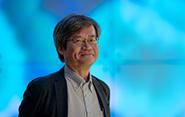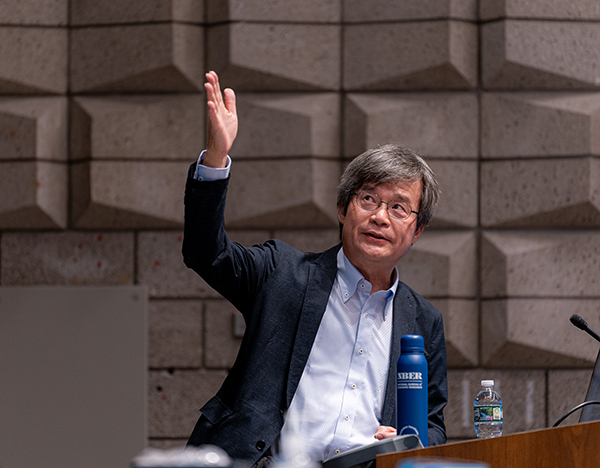Nobel Winner Hiroshi Amano Tells of the Hard Road to a Bright Future

The invention of blue light-emitting diodes (LEDs) has paved the way for numerous technologies that has made our lives easier in many ways. They’ve allowed for bright and energy-saving white light sources and full-color flat panel displays.
The process of actually inventing them was anything but easy, though, as Hiroshi Amano discussed Tuesday in Davies Auditorium as this year’s Nyquist Lecture speaker. For his work, Amano won the Nobel Prize in Physics in 2014.
 In his inspiring and often humorous talk, the professor at the Institute of Materials and Systems for Sustainability at Nagoya University in Japan outlined the many setbacks that besieged him toward growing high-quality gallium nitride (GaN), the material used to develop blue LEDs. It involved years of failed experiments, working out of a poorly resourced laboratory, and a science establishment that was not at all on board with Amano’s chosen pursuit.
In his inspiring and often humorous talk, the professor at the Institute of Materials and Systems for Sustainability at Nagoya University in Japan outlined the many setbacks that besieged him toward growing high-quality gallium nitride (GaN), the material used to develop blue LEDs. It involved years of failed experiments, working out of a poorly resourced laboratory, and a science establishment that was not at all on board with Amano’s chosen pursuit.
Amano began focusing on realizing high-quality GaN crystals as an undergraduate at Nagoya University. He operated out of a makeshift lab assembled from donated used equipment, including handmade coils made from beer bottles. For 364 days of the year (the university always closed on New Year's Day), he worked on growing the crystals with a system known as metal-organic vapor phase epitaxy (MOVPE). He didn’t find success, but he learned to enjoy the process.
“The experiments I did from my first year to third year of undergraduate were not fun because they were made by young research associates and I knew the result before I did the experiment,” he said. “But this time we made our own MOVPE reactors and I was able to think about the experiments on my own. That's very important. I have never had such enjoyable experiments. That's why I could concentrate on performing the experiment and doing the research.”
He entered the doctoral program at his university. “I was able to go on to the doctoral course program so I could live in this way a life where I can pursue what I want to do,” he said.
It was there that he was finally able to grow high-quality GaN. When he first saw the results, Amano thought he must have done something wrong. “But I checked to make sure that I did not have made a mistake. I looked under the microscope and found that perfectly flat gallium nitride had grown. I was moved beyond words.”
He published a paper on the success. It was ignored by the science community, which had moved onto other things. Undeterred and buoyed by a “totally unfounded confidence,” Amano proceeded to hone his work. As a research associate at Nagoya University in 1989, he grew doped GaN that for the first time allowed for the mass production of blue LEDs.
Fast-forward 25 years - long after Amano had given up hope that the Nobel committee had any interest in LED technology. He was traveling abroad the day his award was announced. He dismissed the many emails filling his inbox as spam, and figured all the journalists at the airport were there for a famous celebrity. They were, of course, there for him. Along with Prof. Isamu Akasaki and Prof. Shuji Nakamura, he had won the Nobel Prize in Physics.
Amano, who currently serves as the director of the Center for Integrated Research of Future Electronics, left his audience with this bit of advice: “Now it is your turn - please do not waste your gifted talent.”
The lectureship is named in honor of Harry Nyquist, Ph.D. (1917), an important contributor to stability theory and information theory. Nyquist received the IRE Medal of Honor in 1960 for “fundamental contributions to a quantitative understanding of thermal noise, data transmission and negative feedback.” In October 1960, he was awarded the Stuart Ballantine Medal of the Franklin Institute “for his theoretical analyses and practical inventions in the field of communications systems during the past forty years including, particularly, his original work on the theories of telegraph transmission, thermal noise in electric conductors, and in the history of feedback systems.” In 1969, he was awarded the National Academy of Engineering’s fourth Founder’s Medal “in recognition of his many fundamental contributions to engineering.”
This lectureship was made possible through a generous gift from J. Robert Mann, Jr., B.E. ’51, Chairman of E-J Electric Installation Co., founded in 1899. He is the sponsor of the J. Robert Mann, Jr., Engineering Student Center and a recipient of the Yale Medal, Yale’s highest award to honor outstanding individual service to the University.
Photos: Daniel Havlat ’25

